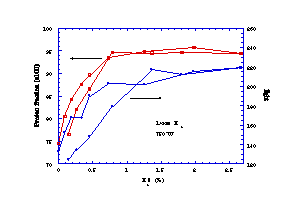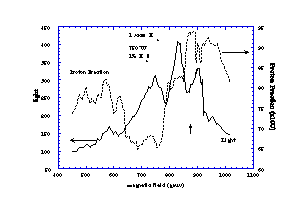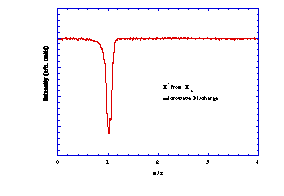We have recently reported [1] the production of cw
proton beams from magnetically-confined microwave-driven sources,
operating under non-resonant (non-ECR) conditions, with proton
fractions greater than 0.95, the remaining fraction consisting
of H2+ (0.05) with no
H3+. We achieve this by the addition of
H2O to the plasma at molecular concentrations of ~1.0%
and about 700 W 2.45 GHz RF power to the source. High-current
(45 mA) high-power (45 kV) beams of >92% proton purity have
been produced using this technique [2]. Additional impurity ions,
O+ at 4 parts per thousand (ppt) and OH+
and H2O+ at << 1ppt are produced.
We report further progress using this technique and similar results
we have achieved for cw D+ beams with D2O
and H2O additives. Finally, we report progress we have
made in the direct extraction of cw H- beams from microwave-driven
sources in terms of ion source surface material and confining
magnetic field configurations. Mechanisms are discussed.
High-current cw proton sources of high reliability are a current requirement for several proposed accelerator applications, including spallation neutron sources and accelerator production of tritium. A desirable property of such sources is that the proton fraction of the extracted beam be as high as possible so as to avoid the need for selection of the desired ion, i.e., to enable direct injection into an accelerating structure. A number of sources have been described in the literature that yield proton fractions on the order of 80% of the extracted beam, the other unwanted components being H2+ and H3+.[3,4,5] Techniques to enhance the proton fraction above 80% are highly desirable.
Similarly, high current H- sources are a requirement
for advanced spallation sources based on circular accelerators
and other circular proton accelerators that use stripping injection,
and for tandem accelerators.
It has long been known that addition of minor constituents to microwave-generated plasmas can modify the species composition of the plasma and can increase atomic neutral fractions relative to molecular species. Systematic studies of atomic hydrogen fractions from microwave-driven plasmas have produced atomic hydrogen beams with close to 100% purity,[6] leading us to recognize that this may be a viable technique for the production of high purity ion beams.
In the case of H- production, pioneering studies
by Hall et al. [7] demonstrated the effectiveness of freshly evaporated
tantalum surfaces in producing copious quantities of vibrationally
excited molecular hydrogen (a required precursor to H- formation).
The observations of Hall et al. appear to never have been deliberately,
or successfully, applied to the production of high-current cw
H- beams.

The major components of our apparatus shown in Fig. 1 include a magnetically-confined microwave-driven (ECR) source purchased from AECL powered by a 2.45 GHz microwave generator (2 kW). The microwave generator is coupled to the source via a circulator and a four-stub autotuner. The ion source is attached to a large high-vacuum oil-free diagnostic chamber with a base pressure of 1x10-8 Torr.
Ion beams extracted at a few hundred volts from the 5 mm source aperture by an accel-decel arrangement are primarily collected on the decel electrode that is in the configuration of a faraday cup. A 0.5 mm aperture in the decel electrode allows a small portion of the beam to be transported to a quadrupole mass spectrometer (QMS) via an electrostatic zoom lens for quantitative beam composition measurement. Light from the ion source is monitored by an optical monochromator by a clear line-of-sight through the QMS (sapphire window). The monochromator continuously monitors the atomic hydrogen Balmer a radiation (656 nm) to give a measure of the atom concentration in the source under varying conditions.
Additives, in this case H2O and D2O
(gas), are introduced into the source along with the H2
or D2 via a micrometer leak valve. The composition
of gas in the source (H2, D2, H2O,
D2O, etc.) is monitored by a residual gas analyzer
(RGA) mounted in the diagnostic chamber.
Most of the measurements reported here are conducted
with the ECR source operating slightly off-resonance, as chosen
by the magnitude of the magnetic confining field. Although operation
off-resonance usually produces a smaller fraction of protons in
the extracted beam, such is not the case in the present experiments
with H2O as an additive.
A) Proton production

Figure 2 shows a beam composition obtained with ~1% H2O added to the source for 1 sccm H2 flow and 700 W microwave power. In this case, the proton fraction of the total beam (consisting of H+ + H2+) is slightly higher than 0.95. Under similar conditions with no H2O, the proton fraction of the total beam (consisting of H+ + H2+ + H3+) is about 0.75, consistent with the measurements of Taylor and Wills [3] obtained under similar non-resonant conditions.
Figure 3 shows the proton fraction (H+/(H++H2++H2+)) and Ha atom emission from the source versus percent H2O added to the plasma. As expected, the proton fraction extracted tracks the concentration of H atoms in the source. The hysteresis in the two sets of curves occurs because the measurements were taken under increasing and decreasing amounts of H2O, which takes a finite time (minutes) to reach equilibrium.

Figure 4 displays the proton fraction (H+/(H+ + H2+ + H3+)) and Ha emission from source with ~1% H2O additive vs magnetic field. Light and proton fraction do not correlate well around the resonance condition. Indeed, maximum proton fraction is obtained at the resonance condition indicated by the arrow, where light is at a minimum. This probably occurs because efficient ionization of H atoms at resonance reduces their concentration and hence the intensity of Ha emission.

b) Deuteron Production
Although not illustrated here, similar increases can be achieved in the deuteron fraction (D+/(D+ + D2+ + D3+)) by addition of H2O or D2O to D2 plasmas, though this increase is less than in the case of H2 as already high deuteron fraction can be obtained in pure D2. Maximum deuteron fractions of about 0.93 are obtained. D2O and H2O are equally effective, although the use of H2O results in minor impurities (H+, HD+) from ion-molecule reactions in the source.
c) H- Production
Production of H- ions in ion sources is
known to occur by dissociative electron attachment of slow electrons
to vibrationally excited hydrogen, H2(v).
e-slow + H2(v) -->
H2-* --> H + H- (1)
where H2-* is an intermediate
temporary negative ion state. It is generally accepted that H2(v)
may be formed by the reaction
H2 + e-fast -->
H2(v) + e-fast (2)
Attempts at direct extraction of negative ions from the standard magnetically-confined microwave-driven ion source described above by ourselves and others [8] have proved fruitless.
This probably arises from several causes. First, the mean energy of the electrons is generally low (~20 eV, Taylor and Wills [3]) and is not conducive to production of H2(v) via equation (2). Second, the electrons in the source are magnetically confined along the axis between the extraction aperture and the microwave window. Thus, even if the weakly bound (0.75 eV) H- species were formed in the source, it likely would be destroyed by collisional detachment by the 20 eV electrons.
However, Hall et. al. [7] have demonstrated alternative techniques for producing H2(v), the precursor for H-. They find that H2(v) can be generated in copious quantities by recombinative desorption of H atoms at surfaces coated with tantalum atoms. We have made use of this observation of Hall et. al. to achieve the first direct extraction of H- ions from a magnetically confined microwave driven ion source.
In order to produce H2(v), the precursor of H-, we have lined the inside of our source with a tantalum sheet to produce H2(v), via the reaction
H + H + tantalum surface--> H2(v) (3)
In order to reduce the flux of 20 eV electrons at the extraction aperture, the source solenoids were moved back from being centered on the source to being centered on the microwave window. This results in the magnetic field diverging and thus diverting electrons at the extraction aperture. Immediate extraction of H- ions was achieved as measured by the QMS.
Electrons necessarily extracted along with the negative ions were removed from the beam prior to mass analysis by a weak (~30 Gauss) transverse magnetic field in the region of the accel-decel electrodes. About 100 mA of extracted electrons were collected on these electrodes.
Shown in Figure 5 is a mass spectrum of H- extracted from the source. Based on the ratio of total H+ extracted to H+ sampled by the mass spectrometer, we estimate this first successful attempt to produce H- resulted in a total H- current of 4-5 mA being extracted from the 5 mm diameter source aperture.

This first data was obtained on August 20, 1996,
and so optimal conditions for H- production have not
yet been achieved. Effects of additives have not yet been studied.
* Work supported by US DOE via Laboratory Directed
Research and Development Funds. We thank C. Batson for continued
technical expertise in this project.
[1] D. Spence and K. R. Lykke, "Generation of High-purity cw Proton Beams from Microwave-driven Sources," Proc. of the 1995 Part. Accel. Conf., Dallas, TX, USA, May, 1995 (IEEE 95CH35843, 1019 (1996)).
[2] D. Spence, G. McMichael, K. R. Lykke, J. D. Schneider, J. Sherman, R. Stevens, Jr., and D. Hodgkins, "Production of High-brightness Continuous Wave Proton Beams with Very High Proton Fractions," Rev. Sci. Instrum. 67, 1642 (1996).
[3] T. Taylor and J. S. C. Wills, "Enhanced High-current ECR Proton Source," Nucl. Instrum. and Meth. A309, 37 (1991).
[4] T. Taylor and J. F. Mouris, "An Advanced High-current Low-emittance DC Microwave Proton Source," Nucl. Instrum. and Meth. A366, 1 (1993).
[5] Y. Okumura, R. Inove, H. Oguri, and H. Tanaka, "Development of a High Brightness Ion Source for the Proton Linear Accelerator (BTA) at JAERI," 1992 LINAC Conference, Ottawa, AECL-10728. Vol 2. P 645.
[6] D. Spence and O. J. Steingrabber, "Factors Determining Dissociation Fractions in Atomic Beams Generated by Straight-through Microwave Discharge Sources," Rev. Sci. Instrum. 59, 2464 (1988).
[7] R. I. Hall, I. Cadez, M. Landau, F. Pichou, and C. Schermann, "Vibrational Excitation of Hydrogen via Recombinative Desorption of Atomic Hydrogen Gas on a Metal Surface," Phys. Rev. Lett. 60, 337 (1988).
[8] J.S.C. Wills, Chalk River Laboratory, private communication.